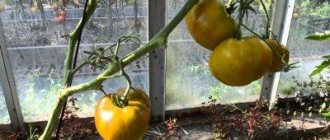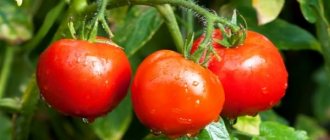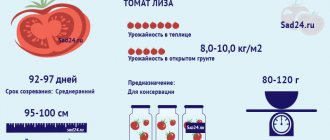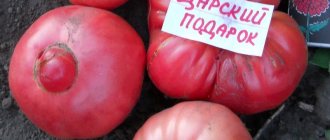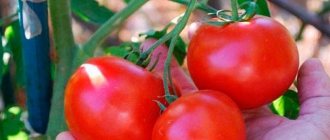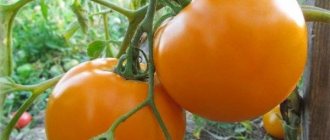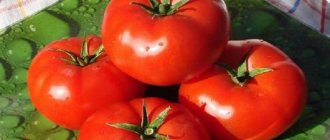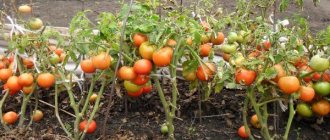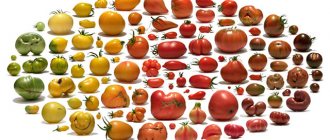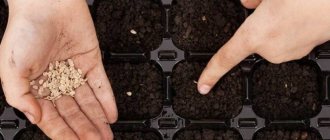Varietal characteristics
This variety belongs to the determinant category. Depending on the climatic conditions of the growing region, it can be mid-late or late. The bushes of the plant are tall and powerful. Their average size is about 160-180 centimeters; in greenhouse conditions, the plant can reach a height of two meters!
From the moment the first shoots appear until the harvest ripens, at least 75 days pass. It should be noted that in mid-latitudes and northern regions, which are characterized by cool summers, this period can increase to 90 days.
The best varieties of tomatoes for greenhouses
If you rank the preferences of modern summer residents, you will get these ratings of the best varieties for a specific purpose and obtaining specific properties.
For an early harvest If you create favorable conditions in the greenhouse by increasing the area of nutrition, light and heat, then the period from germination to fruit can be reduced even to 20 days. And the “earliest” today are considered to be such hybrids with superdeterminant and determinant growth types as:
“Yarilo” “Druzhok” “Blagovest” “Scorpio” “Funtik” “Gina” “Semko-Sinbad” “F1 Soyuz 3” “F1 Soyuz 8” “Cavalier” “Red Cheeks” “Shustrik F1” “Rosy Cheeks”
For chronically infected soil It often happens that in a greenhouse, even expensive steaming does not help cope with constant late blight, mosaic and other misfortunes. In this case, it is best to purchase tomato seeds for greenhouses only from the following brands:
READ ALSO: Use or get rid of shoots next to the plum
“F1 Roma” “Budenovka” “Erema F1” “Evpator F1” “Intuition F1” “Chio-chio-san” “Blagovest F1” “Kostroma F1”
For wet soil If the area is quite swampy, the best varieties of tomatoes for greenhouses will then be:
"Yablonka" "F1 Talitsa" "F1 Chelbas"
For excellent taste and quality But “for yourself”, for small-scale cultivation of your own, environmentally friendly tomatoes and their further canning, these juicy, melting varieties of tomatoes for greenhouses are most suitable:
“F1 Buddy” “Pink Giant” “Tomato Miracle of the Market” “Dessert” “Black Prince” “Sultan F1” “Torbay F1” “Khlynovsky F1” “Rosemary F1”
For the northernmost regions, the following varieties will not be afraid of the harsh climate, frequent frosts and scarcity of sunlight:
“F1Verlioka” “De Barao” “F1 Olya” “Admiralteysky” “Ural F1”
For long-term storage and transportation But for those who grow tomatoes for sale and plan to store them for a long time or transport them over long distances, the following varieties are more suitable:
"Volgogradets" "F1 Salahaddin" "F1 Krasnobay" "F1 Akatuy" "F1 Ivanovets"
source
Tomato Rome: characteristics of fruits
The variety is characterized by excellent yield and a large number of fruits. The average weight of one tomato is about 600 grams. Experienced gardeners say: by monitoring the ovaries and observing all the care features, including fertilizing, they managed to grow tomatoes weighing 1.5 kilograms! The shape of Rome tomatoes is round, slightly flattened. The size is quite large, there is ribbing. Once the fruits reach technical maturity, the color of the tomatoes becomes rich red. Tomatoes are distinguished by excellent taste, meatiness and sweet taste. In reviews of the Rome variety of tomatoes, summer residents say: it is best suited for making salads and tomato juice.
Mid-season varieties
Mid-season tomatoes include tomatoes that ripen approximately 110-120 days after germination. Such species have a very developed rhizome and bush.
Male dignity (Auria). Tall variety up to 2 m, ripening occurs after 110 days. The fruit has an oblong shape (up to 14 cm), its weight is 180 g. The fruits have a red tint. The tomato is fleshy, does not burst and is stored for a long time. Ideally grows anywhere, disease resistant.
Bull's heart. The first harvest can be harvested after 125-135 days, a tall variety - up to 1.5 m. The fruit is pink in color, weighing from 0.3 to 1 kg, and has an excellent taste.
De Barao. The variety is distinguished by a variety of colors from yellow to black, in various shades. The bushes grow up to 3 m in height, the harvest is harvested after 120 days. Tomatoes weighing up to 120 g. The variety is resistant to some diseases and is intended for greenhouse cultivation.
Pinocchio. Harvesting begins after 110 days; the tomato is very small in stature, only 20-30 cm, ideal for growing in any conditions. He feels good in the apartment, on the balcony and window sills. Scarlet tomatoes, weighing up to 20 g. The crop can tolerate a large number of diseases.
Tomato It's full. Ripening occurs after 115 days; they can be grown in greenhouses or greenhouses without any problems. The fruits are large, weighing up to 0.2 kg, red.
Features of sowing seeds
In order to get the maximum yield from each bush, gardeners recommend treating the seeds and soil before planting. It is best to sow seeds in the last ten days of February or the first ten days of March. At least 60 days must pass before you transfer the seedlings to a permanent place. A weak solution of potassium permanganate and hydrogen peroxide is suitable for disinfecting seeds. The soil also requires disinfection: it must be calcined in the oven at a temperature of no more than 100 degrees, and spilled with a slightly pink solution of potassium permanganate. Seeds can be planted either in individual peat pots or in boxes with pre-drilled holes.
Gardeners recommend deepening the planting material no more than a centimeter. After this, the seeds should be sprinkled with soil and then covered with glass or film until the first shoots appear. When the plant has two true leaves, picking should be done. This procedure is not necessary if you plan to plant Rome tomatoes in individual containers.
Experts recommend applying fertilizer twice at the seedling stage. The first feeding should be done 5-10 days after the picking procedure, and one to one and a half weeks before transferring to a permanent place another feeding will be required.
Transplantation to a permanent place
Tomatoes of this variety can be grown both in a greenhouse and in open ground. If you plan to plant plants in a closed heated greenhouse, you can plant it as early as mid-April. Seedlings should be planted in open ground after the last frost; the optimal time is the second half of May.
First, you need to prepare the holes for germination. The best scheme is 50 by 60 centimeters. Experienced gardeners do not recommend placing more than two or three plants per square meter. Before planting, add a small amount of mineral and organic fertilizer to each hole, and then moisten thoroughly. Only after this can the tomato be planted in a permanent place. Immediately after this procedure, you need to water the ground under the bush again and mulch it.
Tomato Rome: description of care features
In order to avoid the most common diseases characteristic of the nightshade family, and to obtain the highest and highest quality harvest possible, you must follow a number of rules:
- Tomato Rome needs pinching. In this case, the bushes should be formed into two, or preferably three, stems.
- Garter. Tomatoes of this variety belong to the tall-growing category; with the application of fertilizers and proper care, the height of one plant can reach two meters. That is why, as the bushes grow, it is necessary to secure the main stem and cluster with fruits.
- Watering. Tomatoes of almost all varieties need plenty of moisture. You can only use warm water for this. Plants should be watered at the roots, being careful not to get on the ovaries and leaves.
- Weed removal and loosening. These procedures are necessary in order to avoid insect attacks and the development of diseases.
- Fertilizer application. Tomato Rome responds well to the application of organic fertilizers. Fertilizing should be done several times per season. The first is required 14 days after transplanting the bushes to a permanent place. After this, the plants should be fed at the stage of flowering and fruit formation.
- The right choice of location. Since the tomato belongs to the late-ripening category, when placed in shaded areas, the harvest will be as late as possible. That is why the greenhouse must have artificial lighting. If you plan to plant seedlings in open ground, you should choose a well-lit place.
Growing
The Rome tomato belongs to the indeterminate varieties, since the growth of its bushes reaches 1.6-1.8 m. When grown in greenhouses, plants can reach 2 m. Other distinctive features of the variety are massiveness, medium-late or late ripening of the fruits, which depends on the growing region, weather and climatic conditions.
The growing season of tomatoes lasts about 75 days or more. In cold conditions, ripening begins only 90 days after sowing the seedlings.
- The average size of each fruit is 600 g. If you properly care for tomatoes, you can get tomatoes weighing 1.5 kg.
- The shape of the fruit is round, slightly flattened.
- The fruits grow large, with pronounced ribbing in the area of the stalk.
- When tomatoes reach maturity, they turn bright red. This rich color distinguishes the variety from other mid-late tomato varieties.
- The structure of the fruit is fleshy, the taste is sweet.
The yield per 1 m² is high, due to the weight of each fruit. Tomatoes are used in salads, fresh and canned, and used to make tomato juice.
Let's look at how to properly grow seedlings. Reviews from summer residents indicate that Rome is propagated only by seedlings.
To get a high yield, you must strictly follow the following rules:
- Seeds should be planted in pots no later than the end of February or early March. Only after 2 months is it allowed to transfer seedlings to greenhouse or open ground.
- Seeds should be planted in special peat pots or seedling containers with a nutrient mixture for tomatoes.
- Before planting, the seeds must be treated with a weak solution of potassium permanganate.
- It is necessary to sow so that there are no more than 2-3 seeds per 1 cm², which go 1 cm deep into the ground. When the seeds are planted, the pots are covered with film to create a greenhouse effect. The film is removed as soon as the seeds germinate.
- When two mature, well-formed leaves appear, the plant must be picked.
- 5-10 days after picking, fertilizing is carried out, when the seedlings are planned to be transplanted into the beds; 7-10 days before this, the tomatoes are again treated with fertilizing.
Tomatoes are planted in open ground only after the last frost, which usually occurs in the second half of May.
The holes should be made according to a 50x60 cm pattern, which will allow you to place no more than 3 bushes per 1 m².
After planting, you need to carefully care for the plants, adhering to the following recommendations from summer residents:
- It is mandatory to carry out pinching, which will allow you to form a bush of 2-3 stems.
- Considering that the bushes grow tall, it is necessary to tie them up. This must be done as the plants grow, securing both the main stem and the clusters with fruits.
- Carry out regular and abundant watering, for which you need to use warm, settled water.
- Remove weeds and loosen the soil in a timely manner so that the tomato bushes do not get sick.
- Conduct timely fertilizing with organic fertilizers. The first time minerals are added 1-2 weeks after the seedlings are planted in the ground, and again when the ovary occurs and the fruits begin to form.
Bushes should be planted in well-lit areas. If the plants are in the shade, they will produce a late harvest.
This variety is planted using pre-grown seedlings. Seeds soaked in a solution of potassium permanganate are sown in small seedling pots at the end of February or before March 10. Two months must pass before the seeds are sent into the ground. They can be planted in peat pots, which can be purchased in advance at a gardening store.
Pots with seedlings are kept on the balcony covered with transparent film until the first shoots appear. Picking is done at the stage of appearance of 2 leaves. The seedlings are fertilized twice during the entire period of being at home. The first feeding is carried out 7-10 days after picking, and the second 10 days before planting in the garden.
The Rome tomato can be grown both in a greenhouse and in open ground. Seedlings can be transferred to the beds only after the end of frost, when there is no threat of sudden cold weather. The bushes can be transferred to closed greenhouse shelters at the end of April, and to the garden bed in mid-May. The holes are made according to the 50x60 cm pattern. No more than 2-3 plants should be placed per 1 sq.m. When caring for tomatoes, it is also worth considering a number of rules:
- To get a rich harvest, tomatoes should be pinched - the bush is formed into 2-3 stems.
- A tall variety needs timely garter. When tying, stems and brushes are secured as necessary. Thus, the bush can grow up to 2 m in height.
- Bushes need frequent watering. To moisten the soil, it is better to use settled warm water.
- Loosening the soil and weeding will help avoid problems such as weeds and root diseases.
- It is recommended to fertilize the bushes several times during the entire growth period. Tomatoes respond positively to organic fertilizers.
- It is worth placing bushes in well-lit areas. A late-ripening variety planted in the shade will produce a harvest later.
It is important to know! After planting the seedlings in the ground, you need to make the first feeding after two weeks, and the second time to feed the bushes at the ovary stage.
